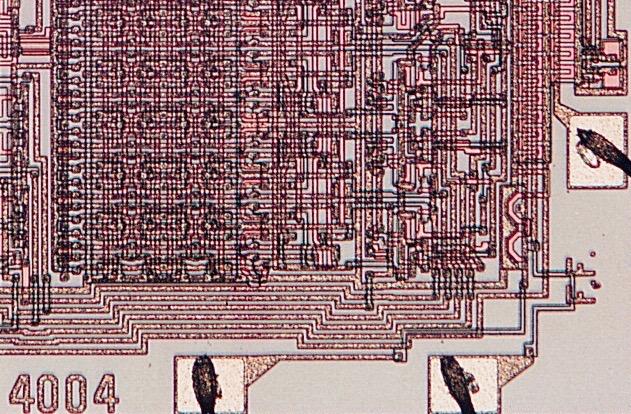|
The 4004, the world's first microprocessor, is signed with the initials F.F., for Federico Faggin, its designer. Signing the chip was a spontaneous gesture of proud authorship. It was also an original idea, imitated after him by others. Faggin initially etched the F.F. inside the design. Later he moved them to its border, like the autograph on a work of art. The signature is a particularly poignant testimony because, at the time of its birth, the first microprocessor, far from being considered a milestone by Intel's management, represented a diversion from the mainline business of the company which was memory chips.
世界上第一款微处理器4004的首字母缩写为F.F.,代表其设计者费德里科·法金(Federico Faggin)。在芯片上签名是对作者身份自豪的自发表现。这也是一个独创的想法,被其他人模仿。法金最初在设计中蚀刻了F.F。后来他把它们移到了边境,就像一件艺术品上的签名一样。这个签名是一个特别令人痛心的见证,因为在其诞生时,第一台微处理器远远没有被英特尔管理层视为里程碑,而是代表着从该公司的主线业务内存芯片转移。
The birth of the 4004 was an intense moment witnessed by Faggin alone, working into the night in the deserted Intel labs. He had received the 4004 wafers from the manufacturing line at around 6 PM, in January 1971, as people were leaving for the day. With hands trembling and heart pounding he loaded the wafers in the wafer prober and connected it to the tester. A sigh of relief raised from his chest, above the humming of the instruments, as he observed electrical activity in the device. As the testing progressed, the tension was gradually transforming into elation as all the critical functions showed to be operating properly. At around 3 AM, exhausted and ecstatic, Faggin left the lab. At home his wife, Elvia, was waiting for the news. "It works"! he announced, and they shared the happiness in this moment of triumph.
4004的诞生是一个紧张的时刻,只有法金一个人在废弃的intel实验室工作到深夜。1971年1月下午6点左右,当人们离开时,他从生产线上收到了4004的晶圆。他双手颤抖,心跳加速,将晶片装入晶片检测器,并将其连接到测试仪。当他观察到设备中的电活动时,在仪器的嗡嗡声上方,他胸口松了一口气。随着测试的进行,随着所有关键功能的正常运行,紧张情绪逐渐转变为兴奋。凌晨3点左右,法金精疲力竭,欣喜若狂,离开了实验室。在家里,他的妻子埃尔维亚正在等待消息。“有效果了”!他宣布,他们分享了这一胜利时刻的快乐。
|

On the lower right-hand corner of the 4004 chip are the initials F.F. for Federico Faggin, the project leader and author of the silicon design. |
Federico Faggin signed the 4004 because:
- He was the leader of the design/development project of the first microprocessor, and brought it to its successful conclusion.
- Faggin did the detailed design work (logic design, circuit design, chip layout, tester design and test program development) with help from Masatoshi Shima, a Busicom software and logic designer without any previous chip design experience.
- Busicom presented to Faggin the engineering prototype of their calculator with the first 4004. Faggin in 1996 donated it to the Computer History Museum in Silicon Valley.
- He was the original developer of the Silicon Gate Technology, at Fairchild Semiconductor in 1968, the first commercial self-aligned gate process, and the designer of the world's first commercial integrated circuit using the silicon gate technology: the Fairchild 3708. This semiconductor technology was copied by Intel and made into its core manufacturing technology, enabling the early realization of high-performance memories and the microprocessor.
- Faggin made two other key inventions at Fairchild: the Buried Contact and the Bootstrap Load. At Intel he applied these innovations to build the first microprocessor. They were essential in making the 4004 a reality with the technology available in 1970. Faggin also created the basic Methodology for Random Logic Design using silicon gate technology. This methodology did not exist at Intel or anywhere else until he developed it in 1970. It set the style of design used for all early generations of microprocessors at Intel.
- He also created a very innovative layout and invented many special circuits, for example: a static MOS shift register, a new type of counter and a new automatic power-on reset circuit (US patent 3,753,011).
- Two patents cover Intel's MCS-4: patent no. 3,821,715, Memory System for a Multi-Chip Digital Computer, in the names of Ted Hoff, Stan Mazor and Federico Faggin (filed January 1973, granted June 28, 1974); and patent no. 3,753,011, power supply settable, bi-stable circuit, in the name of Federico Faggin (filed March 13, 1972, granted August 14, 1973).
After designing the 4004, Federico Faggin intensely promoted within Intel the broad commercialization of microprocessors, which at the outset were only custom products, to the general market. He was in charge of the design and development of all Intel's early microprocessors: the 4004, 8008, 4040 and 8080.
在设计了4004之后,费德里科·法金在intel内部大力推动微处理器的广泛商业化,从一开始,微处理器只是定制产品,进入普通市场。他负责英特尔早期所有微处理器的设计和开发:4004、8008、4040和8080
He conceived and defined the architectures of the 4040 and of the 8080, and supervised their design and development. He presented his architectural proposal for the 8080 to management in early 1972, urging his boss to start the project in earnest, but management wanted to ascertain the market reaction to the recent introduction of the 4004 and 8008 before committing additional resources. Nine months of competitive advantage were thus lost due to this indecision. Intel was then a semiconductor memory company and microprocessors were not a priority.
他构思并定义了4040和8080的体系结构,并监督和管理了它们的设计和开发。1972年初,他向管理层提交了8080的架构方案,催促他的老板启动该项目,但管理层希望在8008的投入额外资源之前确定市场对最近推出的4004。由于这种犹豫不决,九个月的竞争优势因此丧失。英特尔当时是一家半导体内存存储器公司,微处理器不是优先考虑的问题。
The silicon gate design methodology and the novel layouts created by Faggin for the 4004 provided a source of techniques and implementation examples that were subsequently used at Intel and other companies for the design of complex random logic chips.
 |



